In 1944, the Pacific Fleet was faced with a serious logistical problem. While a bewildering variety of ships had made it possible for the Pacific Fleet to operate out of a primitive island lagoon, saving weeks shuttling back and forth to the nearest permanent base, the carriers only carried enough ordnance for three or four days of strikes. This had been adequate for facing the Japanese fleet, or for pounding isolated islands into submission, but there was no way to provide sustained air power for the final push if the carriers had to spend three-quarters of their time shuttling back and forth to the fleet's base at Ulithi.
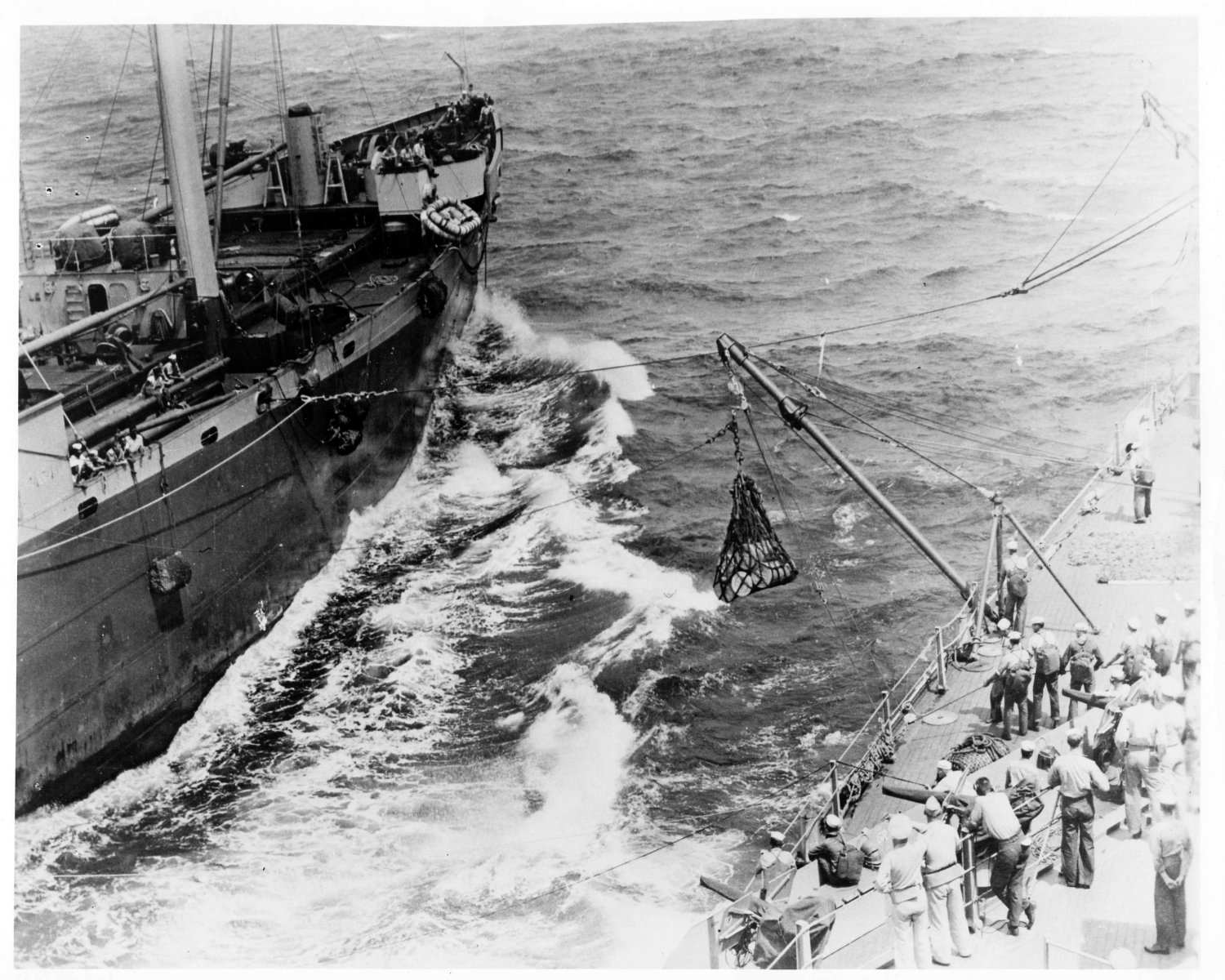
Missouri receiving 16" powder tanks from ammunition ship Mount Baker
The Fifth Fleet logistics staff were tasked with coming up with a solution, and they managed to devise one within a matter of weeks. In essence, it was very simple. All of the existing ammunition ships had booms1 to allow them to move ordnance to ships tied up alongside. A line was run from one of these booms to the receiving ship, where it was attached to a line from a winch, and a cargo hook was hung from the junction. This was used to suspend the ordnance to be delivered, which was then hauled across and struck down into the ship's magazines, just as it would be in harbor. The whole operation very much resembled underway replenishment of fuel, except that instead of simply pumping liquid, thousands of pounds of ammunition had to be manhandled on deck.2 500 and 1000 pound bombs were a particular challenge, as they had to be rolled across the deck, and could easily pulp limbs if they got out of control.
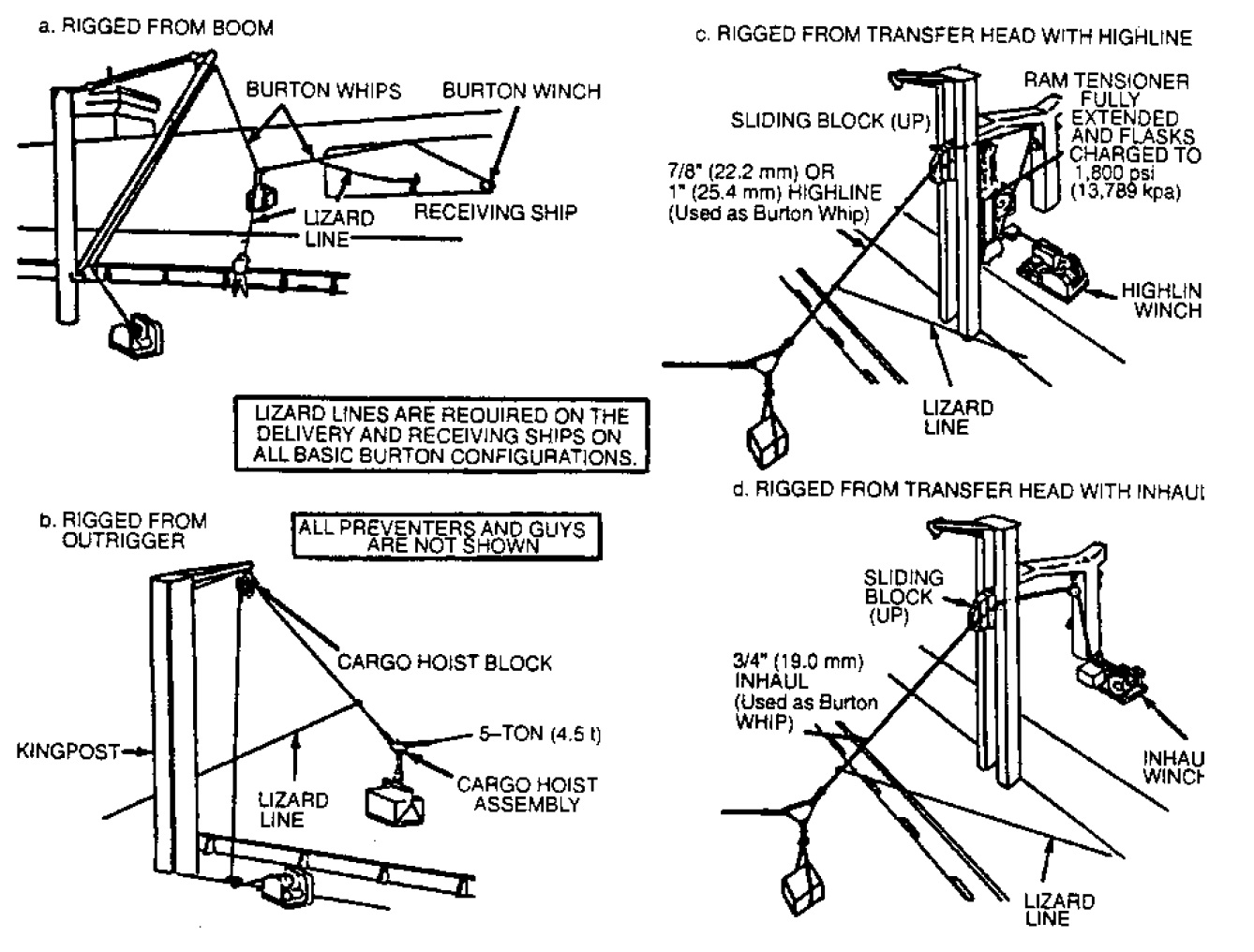
The Burton UNREP method, named after Burton Biggs of the Fifth Fleet logistics staff3
The first operational use of this technique was on February 23rd, 1945, when the ammunition ship Shasta transferred bombs to the carrier Bennington. Soon, it was incorporated into the at-sea fueling groups that had been developed in late 1943. Before the invasion of Tarawa, oilers had primarily been attached to specific task forces and used to refuel the ships en route. For Operation Galvanic, this was reversed. The oilers were grouped into their own task force, and essentially set up an oceanic gas station where other ships came to refuel. When they were empty, the oilers were sent back to Pearl or another forward base to refill their tanks. The location of the rendezvous was changed daily to protect against air and submarine attack.
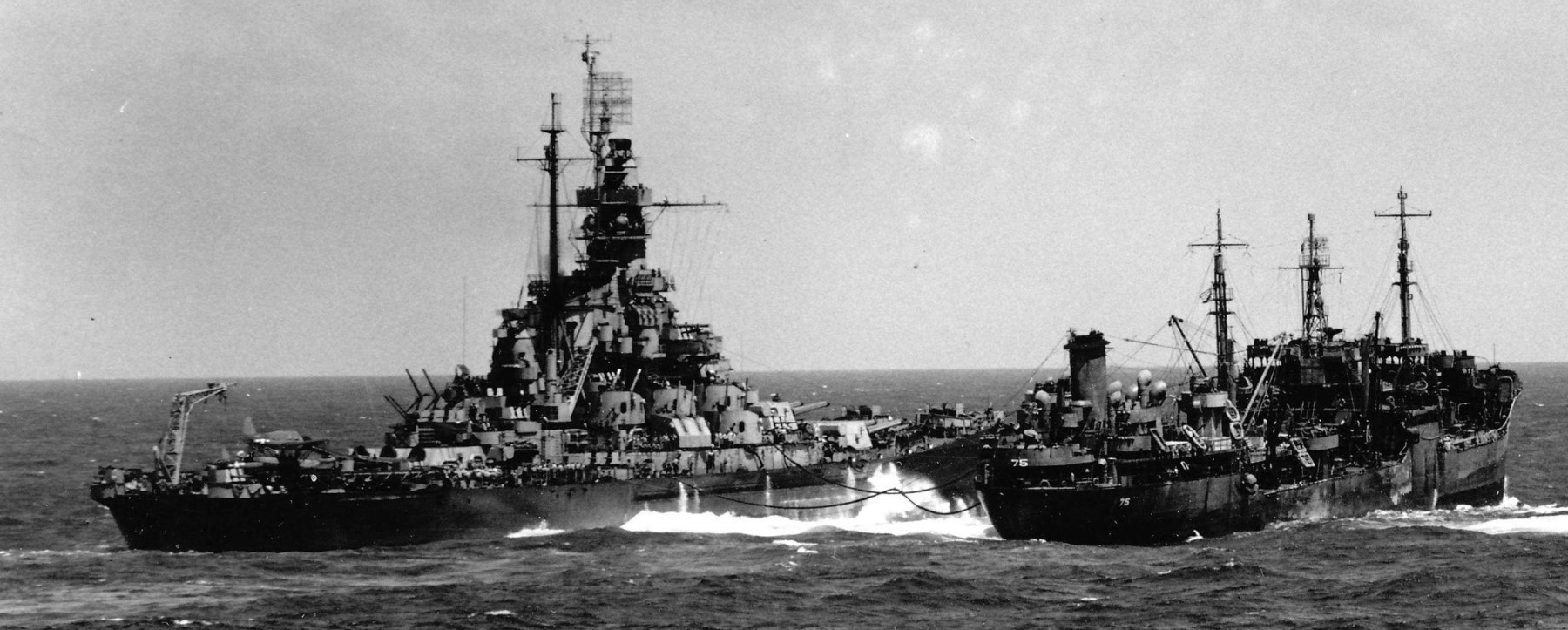
Massachusetts refueling from Saugatuck off Okinawa
For the invasion of Okinawa, the 15 oilers of the Logistic Support Group were joined by a quartet of ammunition ships. After topping off from the oilers of one of the four divisions, carriers would come alongside the assigned AE and take on ammunition. A cargo ship was soon added to the mix, transferring food and supplies, and for the first time, a fleet at sea was supplied with everything it needed to keep operating. The following table4 shows the supplies provided at sea during the invasion of Okinawa.
| Fuel oil | 10,133,000 barrels |
| Diesel | 323,000 barrels |
| Avgas | 25,573,000 gallons |
| Bombs and ammunition | 16,373 tons |
| Replacement aircraft5 | 998 |
| Replacement aircrews | 220 |
| Refrigerated provisions | 2,219 tons |
| Dry provisions | 4,005 tons |
| Ship's stores | 575 tons |
| 15,398 bags | |
| Passengers | 1,240 |
| Replacement personnel | 1,032 |
This capability became increasingly important as the war drew to a close. The Fast Carrier Task Force would launch two days of strikes on Japan, then steam all night to the replenishment rendezvous. There, the ships would first come alongside the oilers, then break off to do the same to the ammunition ship, followed by the stores and provisions ships. After a day of replenishing, the ships would spend the night steaming back towards their targets for two more days of strikes. This allowed the carriers to remain at sea continuously, rotating groups back to Ulithi and other bases for rest and repairs. The entire procedure was time-consuming and could not be done in the face of serious air or submarine threat. Admiral Nimitz began to think that there might be a better way, a one-stop ship capable of providing fuel, ammunition, supplies and refrigerated food at the same time.
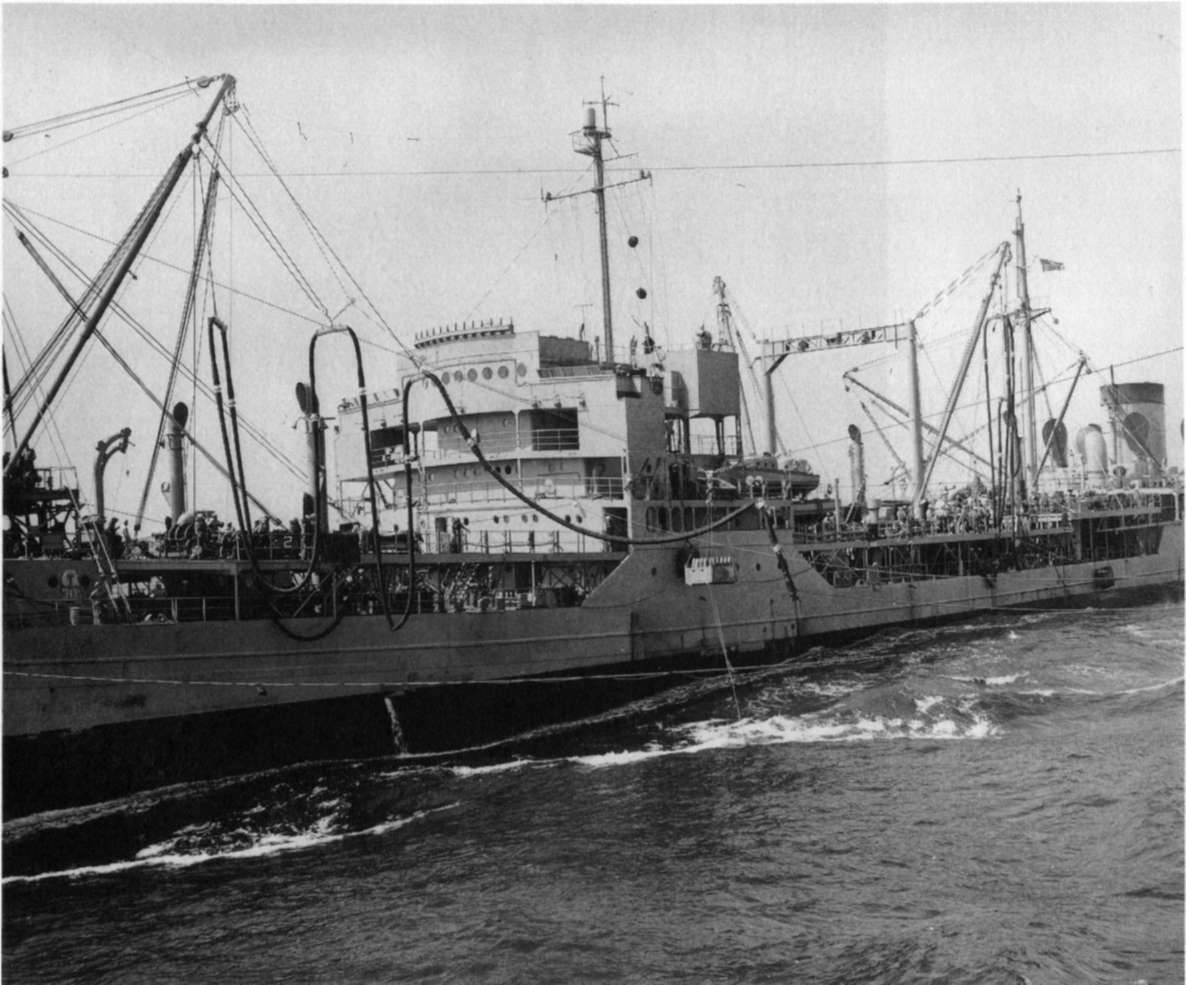
Conecuh transferring fuel and 5" gun ammo at the same time
Weirdly, he was not quite the first to think of this, or even the first to put it into practice. The Germans had beaten him to it by almost a decade, building five fuel/supply ships to support their raiding strategy, although the ships were not designed or equipped for underway replenishment.6 One, the Dithmarschen, was handed over to the US as a war prize in 1946. Plans were swiftly made to convert her to a prototype one-stop underway replenishment ship, although budget cuts meant that this didn't actually take place until 1953, when she entered service as USS Conecuh. She was sent to the North Atlantic and Mediterranean to gather information on the one-stop concept, and despite the issues caused by a lack of spare parts, the cruise was a resounding success, and plans were made to build new one-stop ships.
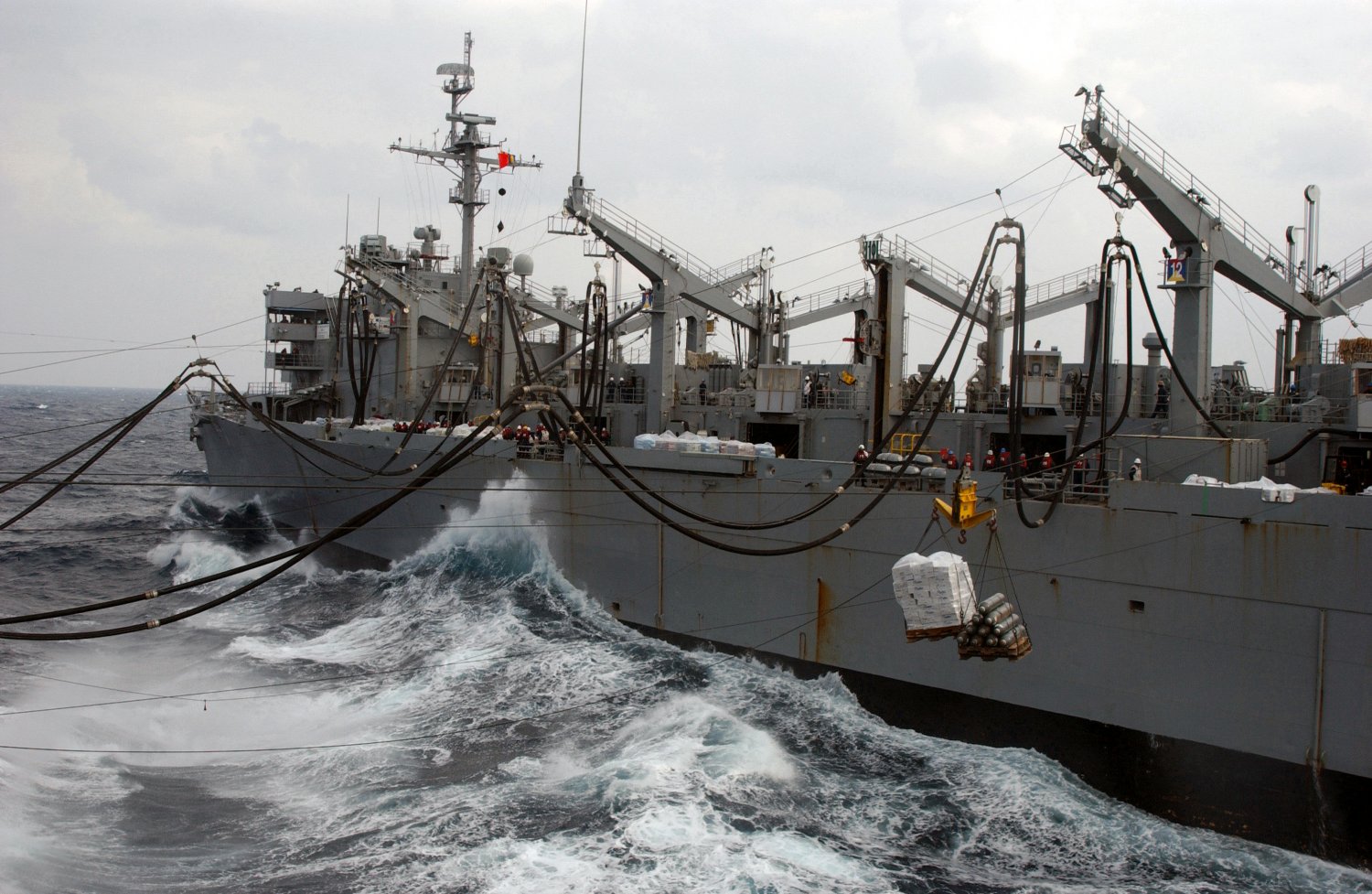
Sacramento transferring fuel and cargo at the same time
From this emerged the Sacramento class of fast combat support ships. These were designed to have the fuel capacity of a fleet oiler and the ammunition storage of an ammunition ship, along with holds for refrigerated and dry cargo. Capable of 30 kts,7 they could keep up with carrier groups, reducing the need for escorts and making sure that fuel and ammunition was always available. The Sacramento in turn would be topped off by other auxiliaries shuttling from forward bases.
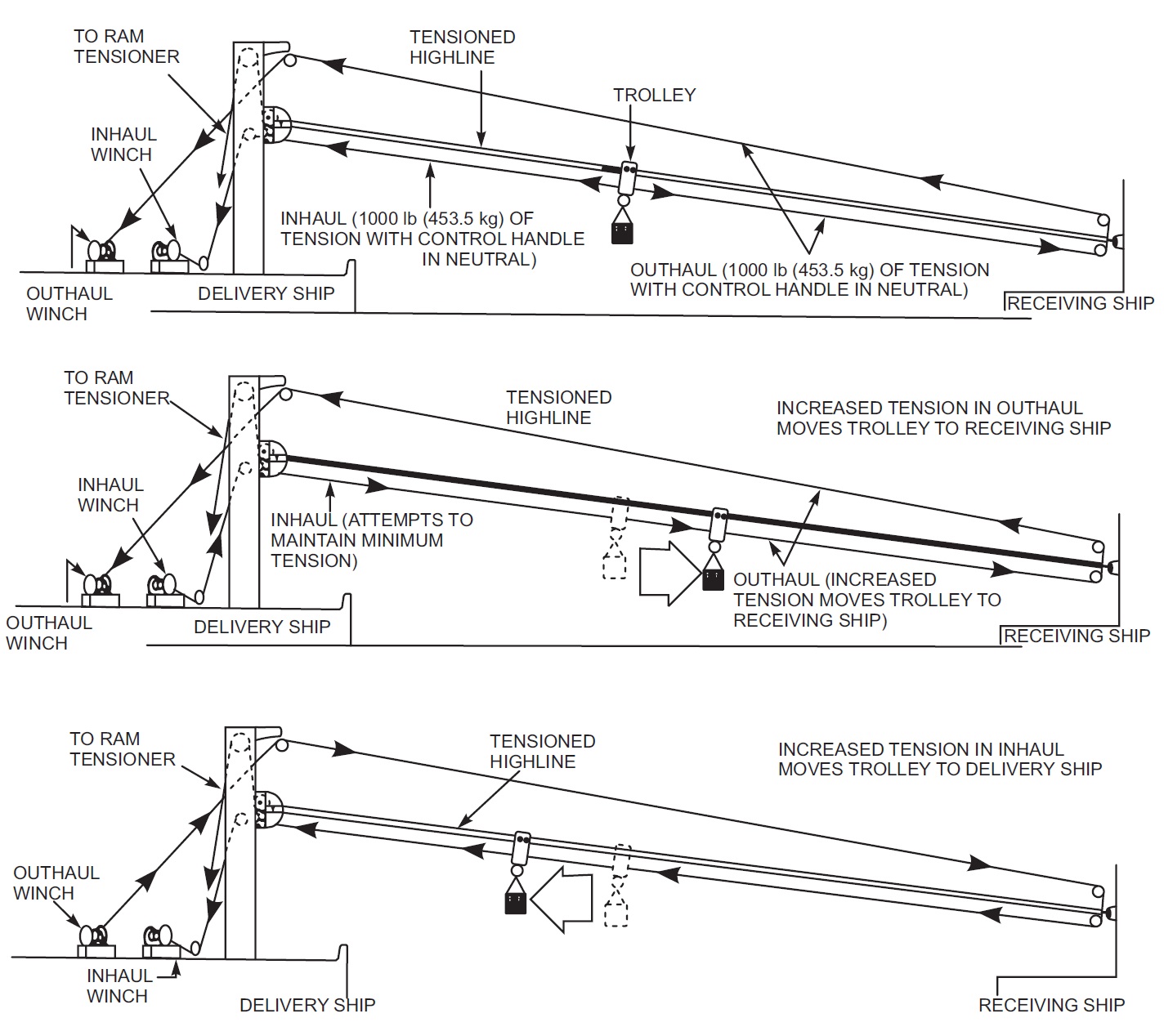
The STREAM cargo-transfer rig
To take full advantage of this capability, improved underway replenishment gear would be required. The existing systems for both fuel and ammunition, while simple, were difficult to use at night or in rough seas. This was made even worse by the need to transfer missiles, which were both heavier and more delicate than the ordnance of WWII. Several systems were tested, and the eventual winner was the system known as STREAM,8 which is used for both fuel and cargo. STREAM involves a tensioned spanwire kept at a constant tension using a ram tensioner on the auxiliary, with trolleys running along the spanwire.9 For fuel, these support the hose, while for cargo, the load is hoisted up to the trolley, sent across the spanwire, and lowered to the deck of the receiving ship. Both methods saw dramatic improvements in transfer speed, time required to hook up the system and conditions under which it could be safely used.
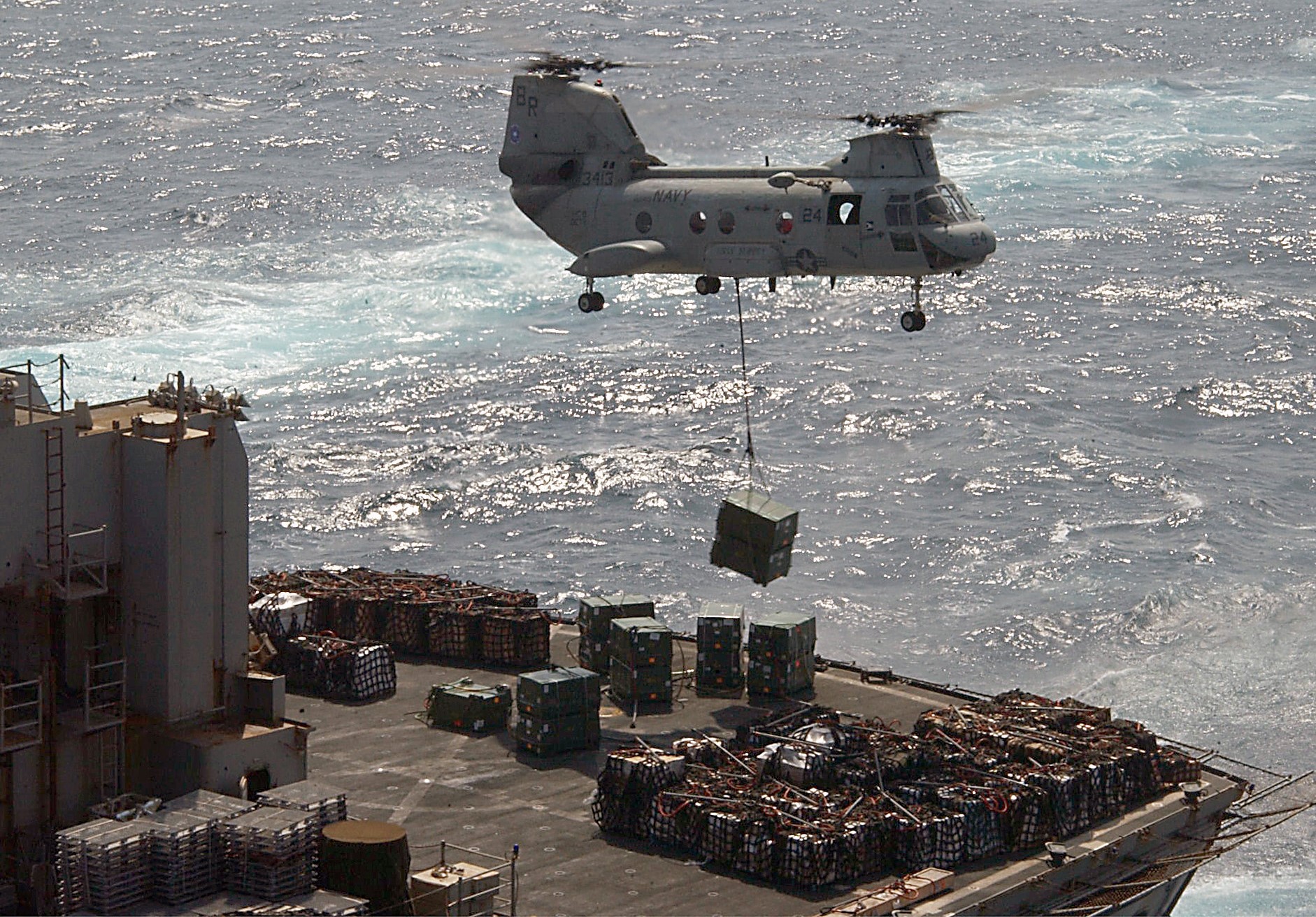
A CH-46 Sea Knight hoists a pallet of ammunition during a VERTREP
The Korean and Vietnam Wars both saw extensive use of underway replenishment to keep the carriers on station and providing air power. The operations off Korea were very similar to those of WWII, while Yankee Station in the South China Sea was able to take advantage of many of the improvements discussed above. However, striking ordnance down on the carriers remained frustratingly slow, at least until palletization was introduced. This alone almost doubled the rate at which ordnance could be transferred, as well as greatly increasing safety. Another major innovation was Vertical Replenishment, or VERTREP, the use of a helicopter to transfer loads between ships at sea. Usually, a helicopter takes a sling load from an auxiliary, and simply sets it on the flight deck of the receiving ship before heading back home. While the transfer rate is somewhat limited and loads over 2 tons can't be moved this way at all, the major advantage of VERTREP is that it does not require the ships to come alongside each other. They can remain on their stations instead of coming alongside the replenishment ship, and might not even need to stop what they're currently doing during the transfer. As such, it has become the preferred method of shifting mail, passengers, and other small loads between ships at sea.
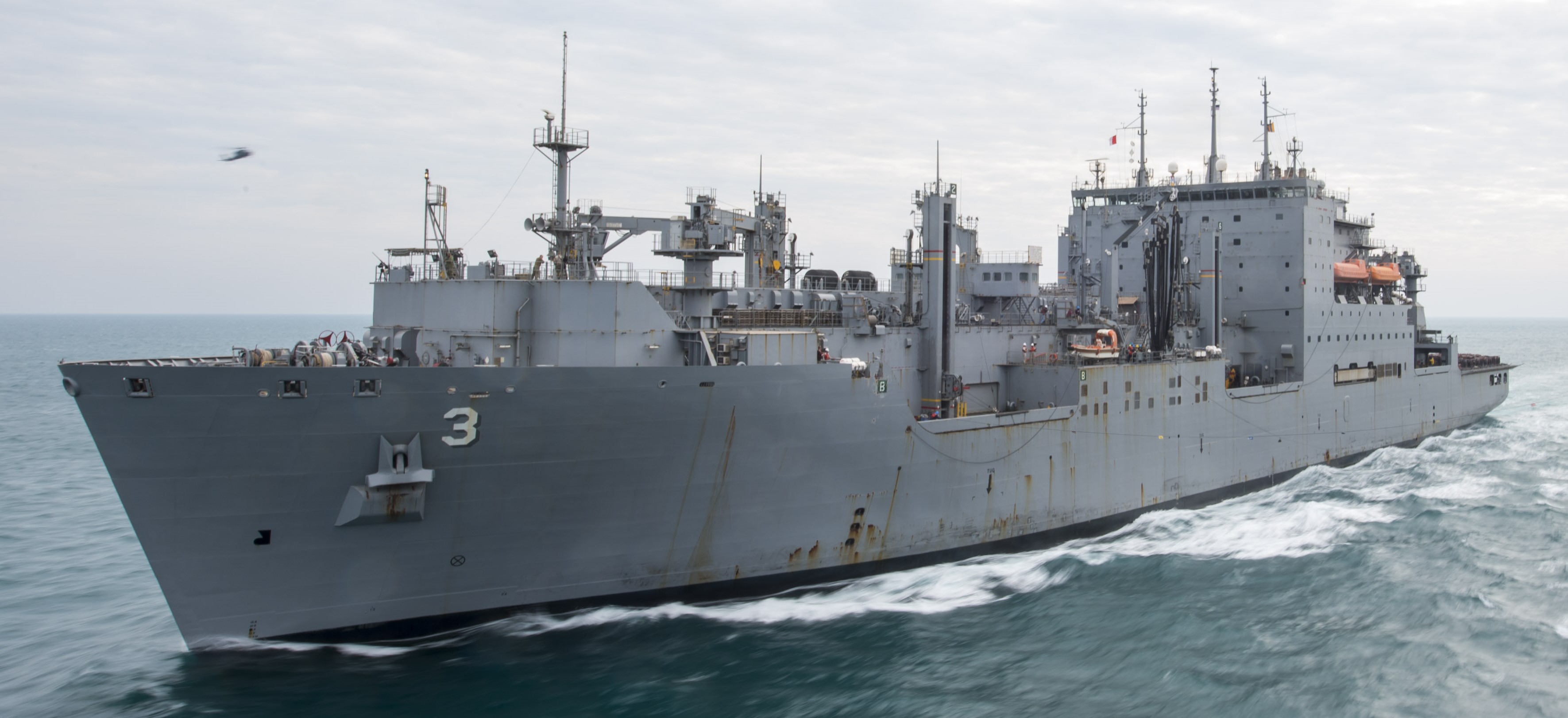
Alan Shepard of the Lewis and Clark class
During the 1970s, the USN, in an effort to reduce costs, transferred most of its auxiliary ships to Military Sealift Command, where they are run by civilian mariners instead of naval crews.10 This has worked out quite well, and MSC today operates a wide variety of vessels that provide vital support to the USN. Among them are the Supply class of fast combat support ships, successors to the Sacramentos, oilers of the Henry J. Kaiser class and the Lewis and Clark class dry cargo ships, which replaced both stores ships and ammunition ships.
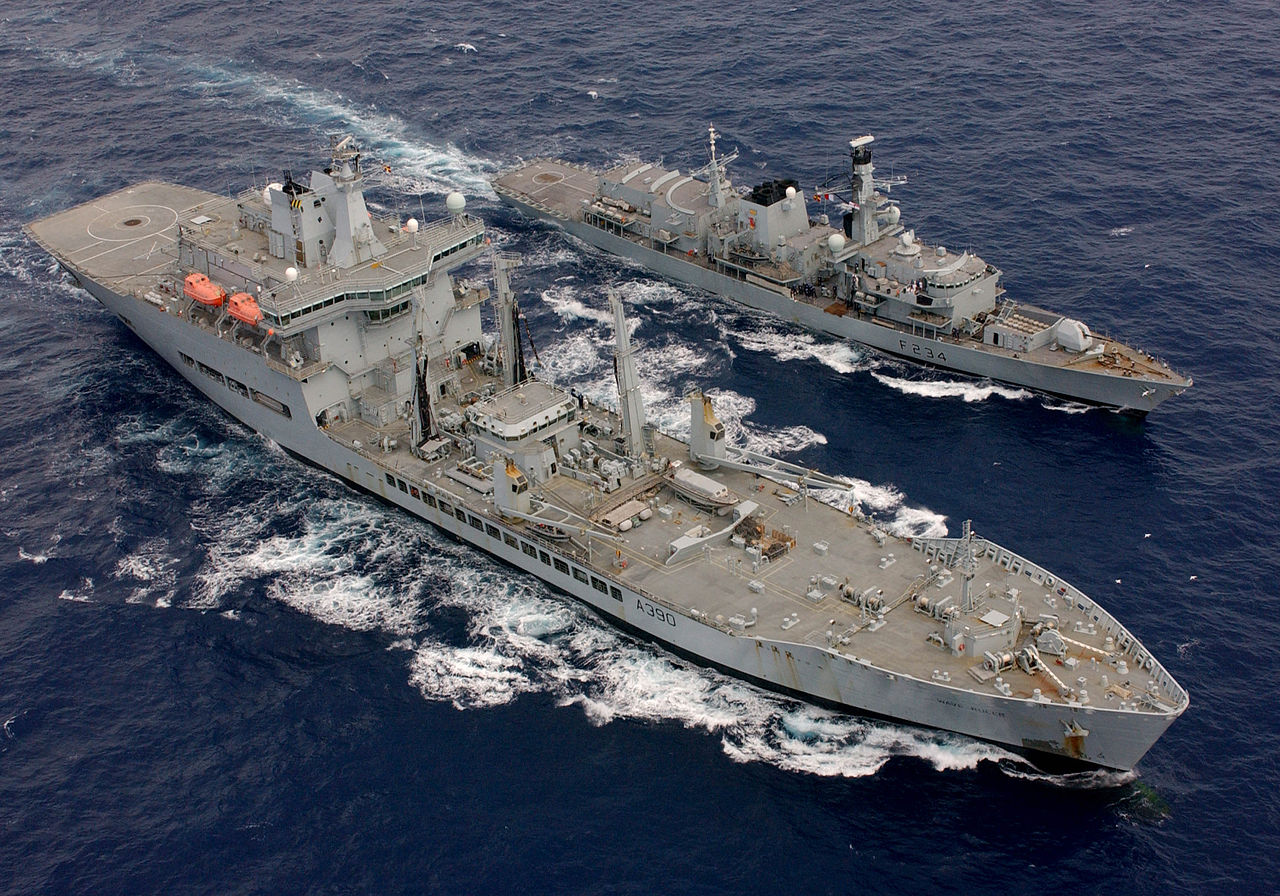
British tanker Wave Ruler refuels HMS Iron Duke
Today, underway replenishment capability is what separates those navies which can project power worldwide from those whose influence is limited to their own coasts. The USN and RN, world leaders in this area, are able to keep warships on-station for months at a time, even thousands of miles away from the nearest base, and both continue to invest in the unloved but ultimately vital auxiliary ships, including both types for unrep and others that operate well away from the main fleet. Without them, the much more visible carriers and destroyers would have trouble even reaching the enemy, much less bringing force to bear.
1 Navy-speak for a crane, although set up slightly differently. ⇑
2 It should be noted that the concept of transferring cargo at sea wasn't totally novel. Highline transfers of men, mail, and small amounts of cargo were common. This method predated the war, and relied on the ship's crew to keep the tension in the line. However, the load limit was only a few hundred pounds, and an airstrike took a lot of 500 lb bombs. ⇑
3 Diagram taken from this manual, which has more details about the use of the methods discussed here, although it's thin on history. ⇑
4 Taken from the book Grey Steel and Black Oil, which covers logistics in the Pacific in great detail. ⇑
5 These were provided by escort carriers tasked with ferrying extra planes to the combat zone. Planes were simply flown off to the carrier that needed them. ⇑
6 They also built the Milch Cow submarines, which operated on a similar principle, providing food, fuel, and torpedo reloads to other submarines. In both cases, replenishment was conducted at sea, but only while stationary. That is theoretically considerably easier, but also obviously increases vulnerability if hostile forces should show up unannounced. ⇑
7 The first two units, Sacramento and Camden, had engines taken from the cancelled battleship Kentucky of the Iowa class, which had been proposed for conversion into a replenishment ship. ⇑
8 Standard Tensioned Replenishment Alongside Method. ⇑
9 STREAM is related to the system known as FAST, for Fast Automatic Shuttle Transfer. FAST was intended to allow a missile to be transferred every 90 seconds, and was very effective when it worked. Unfortunately, this was rare due to the system's complexity, and STREAM, which used the same principle but could only transfer one missile every 5 minutes, was chosen instead. ⇑
10 The British have a similar arrangement for their UNREP vessels, which are operated by the Royal Fleet Auxiliary (RFA). ⇑

Comments
With so many capabilities moved aboard ships, how necessary was Ulithi the atoll to Ulithi the base? Would auxiliary operations have been viable stationary on the open sea?
A good question, but probably not. Being in an atoll is really helpful on several counts. First and foremost, you're protected from the sea. Whereas if you're trying to bring your small boat (carrying mail, food, or replacement typewriter ribbons) alongside a battleship in the open sea, and a wave hits just wrong, it's not going to be a good thing. Being underway makes it a lot easier for both ships to control what they're doing. Second, it's a lot easier to defend, particularly against submarines. Mines, nets, and a few patrol craft make it pretty easy to be certain that nobody is going to pump torpedoes into your destroyers while they're alongside the tender. This isn't possible on the open sea. Third, you can anchor. Ships don't drift with the wind, or otherwise move about. You can shut them down a lot more than is possible in the open sea, which is good for doing maintenance and the morale of the crew. Lastly, remember that a lot of the stuff at Ulithi was pretty slow. The concrete barges had to be towed, as did the floating drydocks. In both cases, they were lucky to make 5 kts. This is acceptable when going from one prepared and defended position to another, particularly when you only have to provide escorts occasionally, but much less so when you're moving them a lot and closer to the enemy.